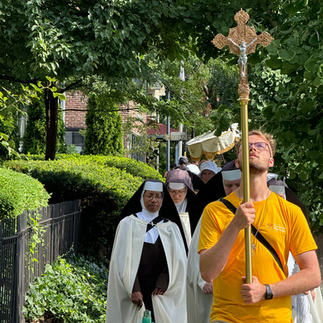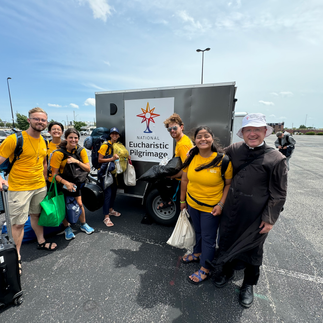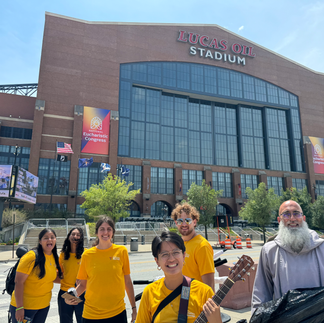Day 60 — Finishing the Pilgrimage and Converging with the Other Routes
- SetonPilgrimage24
- Jul 17, 2024
- 5 min read
Updated: Jul 18, 2024

INDIANAPOLIS, July 16 — The Seton PIlgrims of the National Eucharistic Pilgrimage completed the physical part of their journey from New Haven, Connecticut to Indianapolis, with a huge Mass celebrated with pilgrims from the Serra (western), Juan Diego (southern) and Marian (northern) Routes at St. John the Evangelist Church in downtown Indianapolis. The Mass was celebrated by Archbishop Charles Taylor of Indianapolis, concelebrated by Cardinal Luis Antonio Tagle, Bishop Andrew Cozzens, Bishop Gerardo Colacicco and a few dozen priests.
The day began with Morning Prayer at the Church of St. Philip Neri in Indianapolis, led by Seton Chaplain Father Roger Landry, followed by a period of Eucharistic Adoration. Then there was a three-mile Eucharistic Procession to St. John the Evangelist Church in which the Blessed Sacrament was carried by Seton Chaplain Giuseppe Siniscalchi, CFR, St. Philip Neri pastor Father Jeffrey Dufresne and Seton Chaplain Father Roger Landry.
About 150 people, including religious sisters from the Daughters of Mary, Mother of Healing Love, the Carmelites of the Sacred Heart of Alhambra (on the memorial of Our Lady of Mt. Carmel) and the Missionaries of Charity, participated.
When they arrived at St. John the Evangelist Church, there was a large crowd outside waiting. Father Landry gave a benediction from the steps of the Church on all those who had accompanied them and those who were awaiting them. After entering the Church with a small group of pilgrims, there was a period of adoration and another benediction.
The Seton Route was the third pilgrimage route to arrive at St. John the Evangelist. It was preceded by the Serra and Juan Diego routes and followed by the Marian route.
At the Mass, Archbishop Thompson welcomed the pilgrims, papal legate Cardinal Tagle, Bishop Cozzens and others present.
In his homily, he spoke about the conversion to which Jesus in the Gospel summoned the people of Chorazin, Bethsaida and Capernaum and the way he summoned them to respond to him with faith.
"Repentance," he said "of course comes from the ability to listen to take to heart and respond to the will of God. Such ability involves a proper attitude of humility, willingness, respect and intention. Such intentionality of maturing in one's Faith like that of being a synodal church involves much time and effort. Ongoing conversion is predicated on a commitment to lifelong formation and education, which is at the Eucharistic heart of the church's Christ centered mission of evangelization and catechesis."
He quoted Pope Francis' recent words about the importance of pilgrimages in his recent Bull of Indiction for the Jubilee of Hope in 2025.
"Setting out on a journey is traditionally associated with our human quest for meaning in life. A pilgrimage on foot is a great aid for rediscovering the value of silence, effort and simplicity of life. Churches along the pilgrimage routes can serve as oases of spirituality and places of rest on the pilgrimage of faith, where we can drink from the wellspring of hope, above all by approaching the Sacrament of Reconciliation, the essential starting point of any true journey of conversion."
Archbishop Thompson said that "a great deal of time and effort has gone into the four Eucharistic pilgrimages arriving here today from the four directional borders of the United States. … Along the way, no doubt there have been opportunities for the celebration of Mass, Eucharistic adoration, meditation on Scripture, liturgical or sacramental occasions, various popular devotions and witness of service. No doubt the hardships of pilgrimage have been experienced along the way as well. Pilgrimage is a spiritual catalyst for transformation, in contrast with a trip where we visit a specific place as a guest or a visitor."
He continued, "Pilgrimages are times when you journey inward, even if your body is facing outward. Over these 27 states, 65 dioceses, 6,500 miles, the perpetual pilgrims who have weathered different things to be at this point have given that witness for our church, proclaiming, fostering, empowering and embracing missionary discipleship, which has been a hallmark of each level of the Revival. The four pillars of the national Eucharistic Revival have been enshrined by the witness of those participating along the way: namely, personal encounter with Jesus Christ, reinvigorating devotion, deepening formation, and missionary sending. At the core of these four pillars is our firm belief in the goodness the truth and the beauty of the Real Presence of Jesus Christ, body and blood, soul and divinity in the most holy Eucharist."
He mentioned Pope Francis' comment on Corpus Christi this year, that "the Eucharist is God's response to the deepest desires of the human heart, the hunger for authentic life. In the Eucharist, Christ himself is truly in our midst to nourish, console and sustain us on our journey."
He concluded, "Today, having made the way through the crossroads of America, all four Eucharistic Pilgrimages converge in Indianapolis to spark the kickoff of the National Eucharistic Congress. There is no magic on display here, but far more than symbolic gestures at work during these sacred days days of gathering as the body of Christ the people of God. We gather in the spirit of communion, participation and mission. We gather to accompany, celebrate, discern, encounter, pray and proclaim what it means to be Church, to be Catholic in the 21st century. We are called to be pilgrim people of God, missionary disciples of Christ, the living body of Christ, transforming the world in the name of our Savior Jesus Christ."
At the end of the Mass, Bishop Andrew Cozzens of Crookston, chairman of the board of the National Eucharist Congress a chaplain on the Marian Route during its first week gave some remarks.
"It's a very moving thing to be here at the end of this pilgrimage," he said. "It's really in a certain way a pilgrimage that almost didn't happen. It was over two years ago, I had 50 priests in Chicago for the National Eucharistic Preachers retreat. The idea of a pilgrimage had already been floated. I had even talked about maybe a coast to coast Eucharistic procession. It was actually Patrick Kelly, the Supreme Knight of the Knights of Columbus, who suggested that maybe we would do four routes and make the sign of the cross over the country, ending at Indianapolis."
He continued, "But I had been convinced that it was logistically impossible. So I had given up on the idea. Then I was cornered by two priests, both of whom are here today: Father John Anthony of the Franciscan Friars of the Renewal and Father Roger Landry. They cornered me and said, 'Bishop, we want to do this,' and Father John Anthony said we'll provide priests from the cfrs for the whole route. Father Landry was already talking about doing it and so I decided that we would try to do it."
"Then, as divine providence would have it, we ran into Will Peterson from Modern Catholic Pilgrim and really it was Will Peterson's team that handled all logistics for this and made it completely possible. So I just want to express a real word of gratitude to Will Peterson and his whole team from Modern Catholic Pilgrim. They did an incredible thing for the the Church in the United States and we're very grateful."
"I said to someone this morning, 'It feels like if we just did this, we could all go home right now. It would have been a great thing. But don't go home, because the best is yet to come! Thank you!"
The Mass was the conclusion of the formal and physical part of the National Eucharistic Pilgrimage. The pilgrims will continue the interior journey throughout the five days of the National Eucharistic Congress and beyond.
After the Mass, there was a lunch provided for all of the pilgrims. At night, there was a celebratory dinner, which will be described in depth in another post.
At a news conference after the Mass, Zoe Dongas and Amayrani Higueldo joined with pilgrims from other routes to share their experiences. Zoe's answer to a question were widely shared on social media.
The following photos were posted on Beth Pack's Facebook page.
































































































































































































































































































